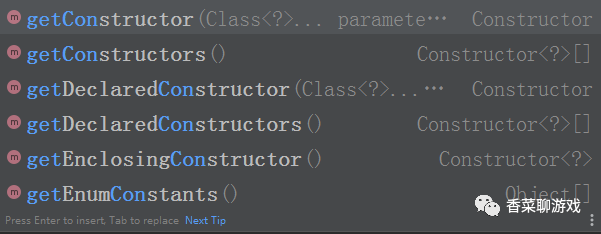一篇文章带你搞定JAVA反射
作者:香菜聊游戏
1、反射的概念
1、概念
反射,指在运行状态中,对于任意一个类,都能够知道这个类的所有属性和方法,对任意一个对象,都能调用它的任意一个方法。这种动态获取信息,以及动态调用对象方法的功能,叫做java语言的反射机制。反射很强大,有优点也有缺点。
优点:灵活性高。因为反射属于动态编译,即只有到运行时才动态创建 &获取对象实例。
缺点:执行效率低。
2、获取字节码文件对象的方式
2.1 元数据的概念
元数据(metadata):元数据是指用来描述类的数据,就是class的代码数据。所有的class文件加载到虚拟机之后都会被构建成class对象,class对象描述了一个类都有哪些东西,大家都知道的实现的接口,继承的抽象类,成员变量,类变量,成员方法,类方法,静态方法等,这个class对象就是元数据。
- Class类:代表一个类。
- Field类:代表类的成员变量(成员变量也称为类的属性)。
- Method类:代表类的方法。
- Constructor类:代表类的构造方法。

2.2 获取class对象的方式
- 通过对象获得,因为任何对象都必须和class对象关联
- 通过类对象直接获得
- 通过类加载器获得,因为类加载器读取class文件会返回class对象
即将用来反射的对象(随便定义的一个对象,只是为了演示)
package org.pdool.reflect;
/**
* @author 香菜
*/
public class Npc {
// 静态field
public static int NPC_TYPE_1 = 1;
// 私有成员变量
private int npcType;
// 共有成员变量
public String name;
// 无参构造函数
public Npc() {
}
// 有参构造函数
public Npc(int npcType, String name) {
this.npcType = npcType;
this.name = name;
}
public int getNpcType() {
return npcType;
}
public void setNpcType(int npcType) {
this.npcType = npcType;
}
public String getName() {
return name;
}
public void setName(String name) {
this.name = name;
}
// 静态方法
public static void sayHello(String word){
System.out.println("hello " + word);
}
}
获取反射class的三种方式
package org.pdool.reflect;
/**
* @author 香菜
*/
public class ClazzTest {
public static void main(String[] args) {
//第一种方式获取Class对象
Npc npc1 = new Npc();//这一new 产生一个Npc对象,一个Class对象。
Class npcClazz1 = npc1.getClass();//获取Class对象
System.out.println(npcClazz1.getName());
//第二种方式获取Class对象
Class npcClazz2 = Npc.class;
System.out.println(npcClazz1 == npcClazz2);//判断第一种方式获取的Class对象和第二种方式获取的是否是同一个
//第三种方式获取Class对象
try {
Class npcClazz3 = Class.forName("org.pdool.reflect.Npc");//注意此字符串必须是真实路径,就是带包名的类路径,包名.类名
System.out.println(npcClazz3 == npcClazz2);//判断三种方式是否获取的是同一个Class对象
} catch (ClassNotFoundException e) {
e.printStackTrace();
}
}
}
1、访问权限
反射机制的默认行为受限于Java的访问控制,可通过 setAccessible 绕过控制。
// 设置对象数组可访问标志 static void setAccessible(AccessibleObject[] array, boolean flag)
2、获取方法

2.1 访问静态方法
public static void main(String[] args) throws NoSuchMethodException,InvocationTargetException, IllegalAccessException {
Npc npc = new Npc(1, "妖神·凰女");
Class npcClazz = Npc.class;
// 第一个参数是方法名,第二个参数是函数的参数class对象,因为存在重载的可能性,用参数类型区分
Method sayHello = npcClazz.getMethod("sayHello", String.class);
sayHello.invoke(npc, "world");
}
2.2 访问类方法
Npc npc = new Npc(1, "妖神·凰女");
System.out.println(npc.getName());
Class npcClazz = Npc.class;
// 第一个参数是方法名,第二个参数是函数的参数class对象,因为存在重载的可能性,用参数类型区分
Method sayHello = npcClazz.getMethod("setName", String.class);
sayHello.invoke(npc, "world");
System.out.println(npc.getName());
3、获取字段,读取字段的值

Npc npc = new Npc(1, "妖神·凰女");
Class npcClazz = Npc.class;
// 获取字段,并设置可访问
Field field = npcClazz.getField("name");
field.setAccessible(true);
System.out.println( field.get(npc));
4、获取实现的接口

5、获取构造函数,创建实例

Class npcClazz = Npc.class;
Constructor declaredConstructor = npcClazz.getDeclaredConstructor(int.class,String.class);
Npc npc = (Npc) declaredConstructor.newInstance(1, "妖神");
System.out.println(npc.getName());
6、获取继承的父类
Class npcClazz = Npc.class; Class superclass = npcClazz.getSuperclass(); System.out.println(superclass.getName());
7、获取注解
Class npcClazz = Npc.class;
Annotation[] annotations = npcClazz.getAnnotations();
// 运行时注解
for (Annotation annotation : annotations) {
System.out.println(annotation.getClass().getName());
}
4、反射实例
获取到元数据不是最终的目的,我们最终的目的是想在运行时去调用,访问类。说了太多,还是举个例子,大家都知道Spring的IOC,怎么实现的呐?
过程:
1、Spring 在项目启动的时间通过读取xml中配置的bean的路径,
2、然后通过Class.forName 读取class 到类加载器,
3、然后通过反射创建所有的bean实例并保存到容器中,启动容器之后,
4、在项目中可以直接获取bean对象。
我们来大概实现这一过程,因为xml的读取比较麻烦,直接用property来代替了。大家体会一下思想就可以了。
package org.pdool.reflect;
import java.io.IOException;
import java.io.InputStream;
import java.lang.annotation.Annotation;
import java.lang.reflect.Constructor;
import java.lang.reflect.Field;
import java.lang.reflect.InvocationTargetException;
import java.lang.reflect.Method;
import java.util.HashMap;
import java.util.Map;
import java.util.Properties;
import java.util.Set;
/**
* @author 香菜
*/
public class ClazzTest {
public static void main(String[] args){
try {
Map<String,Object> container = new HashMap<>();
//1.读取配置
InputStream in = ClazzTest.class.getResourceAsStream("/beans.properties");
Properties property = new Properties();
property.load(in);
//2.反射创建对象
Set<Object> keySet = property.keySet();
for (Object key : keySet) {
// 2.1 获取类的全路径
String classStr = (String) property.get(key);
// 2.2 加载class 到虚拟机
Class<?> beanClazz = Class.forName(classStr);
// 2.3 获取缺省的构造函数
Constructor<?> declaredConstructor = beanClazz.getDeclaredConstructor();
// 2.4 创建实例
Object o = declaredConstructor.newInstance();
container.put((String) key,o);
}
// 3.获取实例
Npc npc = (Npc) container.get("npc");
System.out.println(npc == null);
} catch (Exception e) {
e.printStackTrace();
}
}
}
5、总结
在使用Java反射机制时,主要步骤包括:
获取 目标类型的Class对象
通过 Class 对象分别获取Constructor类对象、Method类对象 或者 Field 类对象
通过 Constructor类对象、Method类对象 & Field类对象分别获取类的构造函数、方法&属性的具体信息,并进行后续操作。
本篇文章就到这里了,希望能给你带来帮助,也希望您能够多多关注脚本之家的更多内容!
